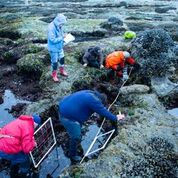Aquarium Supports Bio-Blitz Program
- Kiera Morgan

- Jul 29, 2019
- 2 min read

Bioblitzes held all along the Oregon Coast this summer saw a great turnout from both locals and coastal visitors alike. The Bioblitzes, aimed at surveying the organisms at each of Oregon’s five marine reserves, took place in early June and July and saw over fifty participants at each public event. The Oregon Coast Aquarium and partners, including the Oregon Department of Fish and Wildlife, Oregon Sea Grant, and Cascade Head Biosphere Reserve, hosted and promoted the Bioblitzes at Otter Rock, Cascade Head, Cape Perpetua, Redfish Rock and Cape Falcon Marine Reserves.
While most of the participants had planned on attending the events ahead of time, many came to the beach to experience the low tide on their own and then decided to participate in the Bioblitz after engaging with the coordinators. The Aquarium also partnered with the Partnership for Interdisciplinary Studies of Coastal Oceans (PISCO) through the Lubchenco/Menge Lab at Oregon State University (OSU) to collect data on intertidal ecology through bird surveys, sea star and mussel transects, and snail counts.
PISCO trained students from OSU and Aquarium volunteers to assist in the data collection prior to the Bioblitzes. “The partnership with PISCO was an amazing way for students to gain field experience and the Aquarium volunteers commented on how this was an amazing opportunity for them to participate in science,” said Katy Nalven, Oregon Coast Aquarium Educator and Bioblitz Coordinator. “This collaboration allowed the public to see scientists in action, in the field, and it helped to demonstrate how research is conducted in the Marine Reserves.”
Bioblitz participants used the iNaturalist App to input species observations and photos, and the data is shared with scientists through scientific data repositories like the Global Biodiversity Information Facility. The Cape Perpetua Bioblitz recorded 5,676 observations of over one thousand species, and the Cascade Head Bioblitz recorded the first iNaturalist record for the Giant Feather Duster Worm (Eudistylia polymorpha) in Oregon. “This fills a gap in the iNaturalist range map for the species that previously spanned from San Francisco to Seattle. Both species are expected to occur here, they just hadn't been recorded in iNaturalist until our efforts,” said Nalven.
The Oregon Marine Reserves are areas in our coastal waters are dedicated to conservation and scientific research, where all ocean development and removal of species is prohibited. Oregon created the marine reserves to conserve marine habitats and biodiversity while serving as living laboratories to learn about Oregon’s nearshore ecosystems and the potential effects that protections can have over time.
In order to understand the effects of the reserves, key information is needed on the original species compositions of each area to establish a baseline i.e. what and and plant species are there and how abundant are they? The Bioblitzes, along with dive surveys and SMURFing (Standard Monitoring Unites for the Recruitment of Fishes), serve as methods for collecting this key information.
Information and photos provided by OCA





.png)



Comments